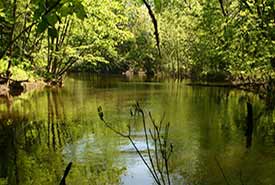Exploring the remarkable Gervais Property

Channel spring, Gervais property, Ottawa, ON (Photo by Daniel F. Brunton).
You can hear it...The sound of rushing water, like a rapids or a waterfall, right in the middle of the woods where no channel exists. Huh? Until then there had been no immediate outward sign that I was in a remarkable spot, let alone one that is unique in Canada. And like in some Grade B Sci Fi movie, I'm drawn to its source, one of several huge pits looming up through the vegetation ahead, some the size of houses. This rarely ends well in the movies; now it's got me.
The giant pits are certainly alien to my southern Ontario experience but thankfully, not to the planet. They are sinkholes where the ground has collapsed into caves, leaving steep-sided depressions of various depths in the limestone bedrock. They're old, very old, and clothed in soil and trees and boulders.
But it's the sound of rushing water in this otherwise quiet but impressive maple forest that startles me. I don't want to get too close to the lip of these sinkholes. That's a long way down. So, looking in to get some understanding of what's down there involves a lot of neck craning.
And that's when I get my answer — there is a small river rushing through this forest. It's not in a conventional channel but in the bottom of the pit. And the water is moving so fast it looks like a rapids. How can this be?
The pit-bottom rapids are in a cave connected directly to the Ottawa River several hundred metres away. It's part of a huge system of such caves here at the northern tip of the Westmeath Peninsula. In fact, this 75-acre (30-hectare) woodland property sits on top of the most extensive underwater cave system ever found in Canada. More than four kilometres of caves have been mapped beneath my feet, under the current river and extending eastward into Quebec — so far. The system is believed to be significantly larger than that.
To be truthful, looking at that cold, dark water racing underground into who knows where makes my blood run cold. But some truly cold-blooded animals are not intimidated at all, including a sizable population of the endangered river sturgeon that uses the caves. That explains the presence of a population of the similarly endangered hickorynut mussels in this stretch of the Ottawa River. The mussel can only survive in association with sturgeon. The cave pools and other submerged pits and grottoes offer prime sites for a variety of more common fish and I am assured by local residents that the fishing is exceptional here.
But back to the woods. Surrounding the sinkholes is a rich, weed-free vegetation with an intriguing variety of representative and rare limestone-tolerant vegetation. I find myself walking through a lush growth of Hitchcock's sedge, previously unrecorded this far north in Ontario or anywhere in Renfrew County. The vine moonseed sprawling through the rivershore thickets nearby is another displaced southern species, not known to grow within 100 kilometres of here along the Ottawa River. Butternut, the native tree that succumbs to a fatal blight and designated as endangered as a result, is also present. The blight has even reached here at the northen edge of its range and all the trees are severely infected.
I encounter other provincially rare plants and at least one other designated endangered species as I make way across the tumbled, rocky landscape of deciduous and mixed forest. I'm seeing 140 native plant species this day, a good total for a woodland in the middle Ottawa Valley. The forest has been logged in the past — virtually all of the Ottawa Valley has — but lightly and without significant negative impact. There are several immense white cedar trees scattered within the woodland, each certainly centuries old, and I can't get my arms around either of one I encounter today. A measurement of the ecological integrity (the "naturalness") of its flora places this property virtually at the top of a cross-section of eastern Ontario woodlands.
Emerging from the woods and slapping away a few last mosquitoes — the downside of exploring such a rich, low forest — I can hear numerous green frogs calling from the woodland in the western half of the property. That woodland is on the same limestone bedrock, over the same hidden caves but with wetter swamp forest cover and I haven't so much as stepped foot in it.
It occurs to me then that as unique and ecologically exciting as the part of the Gervais Property I have explored turns out to be, there has to even more to it. What a fine promise for another day.

